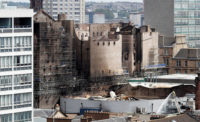In 1967, while I was an architecture student at the University of Washington in Seattle, my History of Architecture professor Hermann G. Pundt presented an hour-long lecture to the class on the Glasgow School of Art and the work of Charles Rennie Mackintosh. It was an unforgettable hour due to Professor Pundt's enthusiasm and passion.
Professor Pundt had devised his own theory and history of modern architecture. Our yearlong education began with Brunelleschi’s Duomo in Florence and its use of iron in tension; progressed through Schinkel’s Berlin works; went on to Louis Sullivan’s buildings in Chicago; and ended with the work of Frank Lloyd Wright. I remember Professor Pundt’s presentation being so great that we never doubted that this was the true history of modern architecture (a narrative in which Le Corbusier didn’t appear). Mackintosh’s work, and especially the 1909 Glasgow School of Art building, occupied a very emotional and important place in my own passion for architecture from that day forward.
Visiting the building for the first time in June 2009, I was very inspired by the vitality of the school and Mackintosh’s use of light. More than 100 years after its completion, the building continues to inspire as a work of architecture and a place to make art. Its original architectural language is as fresh today as it was then. It is a symphony of light in many movements—a tone poem in north, south, and top light, with dark melancholic movements. Its organizational structure, based on well-proportioned studios, provides ideal spaces for teaching and making art and it has proven adaptable to changes in art practices and media.
The shock of seeing the Glasgow School of Art in flames on May 23 brought deep sadness and a sudden feeling of monumental loss. This building was and still is more than just crucial in the history of architecture. It stands as a breakthrough for modern architecture. Most importantly, it is a living and working place, deeply inspiring students.
The Glasgow School of Art embodies a refreshingly direct conviction: When you are working in a building that embodies great ideas, it lifts you above the misery of cynicism, gives you strength, and you can—if you persevere—find your own convictions and arrive at your own core values as an artist. The present intellectual climate in art and architecture could use any force it can muster against cynical reason and sarcasm.
The material and spatial energy of the building has just enough magnitude to present students with an ideal world in which to work and develop. This is why the building must be rebuilt and remain a school of art. Winston Churchill’s diction, “We shape our buildings; thereafter they shape us,” has no greater example than the Glasgow School of Art, precisely because it has continued to produce students and launch them into the world every year since 1909. Therefore, we must all work rapidly for its complete restoration. We should challenge ourselves that only one year will be lost, and Mackintosh’s Glasgow School of Art will again launch students into the world in 2016. Georges Braque once said, “The only thing that matters in art is what cannot be explained.” The Glasgow School of Art has an inner worth and a dignity beyond all measurable value.



Post a comment to this article
Report Abusive Comment